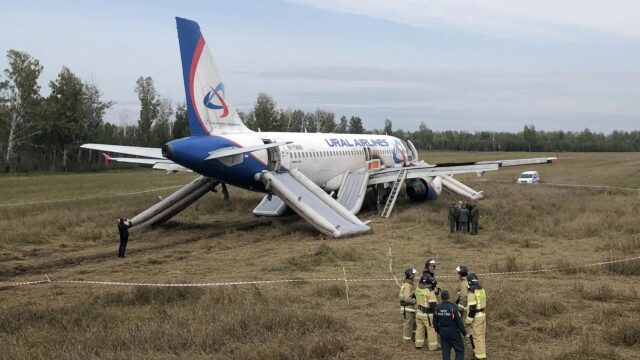
War in Ukraine Disrupts Russian Civilian and Commercial Aviation
Publication: Eurasia Daily Monitor Volume: 20 Issue: 190
By:

Over the past month, as many as ten forced landings of civilian aircraft have taken place in Russia. The most serious of these happened over the past week. On December 7, a fire on board an Aeroflot Airlines Boeing 777 forced the aircraft to make an emergency landing. The plane was flying from Kamchatka to Moscow when a passenger noticed smoke coming from under his seat. The preliminary investigation attributed the fire to a short circuit of wiring in the main cabin (T.me/aviatorshina, December 7). That same day, a Tu-204S cargo plane of Aviastar-Tu Airlines with registration number RA-64024 was returning from Zhengzhou airport in China. After takeoff, the pilot reported to air traffic controllers that the left engine had stalled and requested an emergency landing at Ulan-Ude airport (Ruavia.su, December 7). And on December 8, a Siberian Airlines Boeing 737 traveling from Novosibirsk to Moscow made an emergency landing in Tolmachevo. Immediately after takeoff, both of the aircraft’s engines caught fire (T.me/aviatorshina, December 8). These incidents highlight growing problems for Russia’s civilian and commercial aviation. Many of the technical difficulties are tied to Western sanctions prohibiting the import of critical components for the proper maintenance of aircraft. The recent forced landings represent another example of the war in Ukraine increasingly being brought home to Russia.
Western sanctions and a critical shortage of technical personnel have hampered Russian civilian aviation since the beginning of the war (see EDM, July 3, September 8). Due to a lack of specialists and necessary spare parts, negligence of management, and Moscow’s fundamental departure from the rules for servicing foreign-made aircraft, much of the Russian civilian fleet could be grounded over the next year, with few prospects for reversing that trend. This is evidenced by the fact that, compared to 2022, the number of flight delays for the Urals MTU of the Federal Air Transport Agency (Rosaviatsia) increased by 44 percent this year (880 in 2023 compared to 490 in 2022). At the same time, there have been 739 cases of flights being unable to depart on time due to technical malfunctions (Insightnews.media, December 7).
The lack of access to software updates and proper technical advice, as well as skipping regular maintenance intervals, have led many of Russia’s civilian aircraft to gradually break down. Most often, engines, landing gear, and brakes are the first to fail. Problems with flaps, air conditioning and de-icing systems, or internal wiring are less common but have been seen increasingly in recent weeks. Thanks to the Kremlin’s orders not to record any defects in pilots’ logbooks, all civilian aircraft appear to be perfectly serviceable on paper (Insightnews.media, December 7).
Moscow’s problems with domestic aviation extend beyond civilian flights to the commercial sector. Russia’s air freight industry is stagnating fast, as it is dominated by the outdated Soviet Ilyushin Il-76 and Ukrainian Antonov AN-24 and AN-26 cargo aircraft. On November 8, the Federation Council held a roundtable discussion on the state of the country’s air transit capabilities (Gazeta.ru, November 9). Some participants expressed fear that up to 25 percent of the commercial fleet will be inoperable in less than five years. The average age of Russian commercial cargo aircraft is 50 years old. These aircraft have not been properly upgraded and maintained due to the mass transfer of foreign aircraft to Russia before the war; the lack of economic feasibility in completing such an overhaul, with costs estimated at billions of rubles; and the inability to gain access to necessary parts to upgrade the Ukrainian cargo planes.
The repercussions of Moscow’s war against Ukraine have forced Russian operators to pay minimal attention to the maintenance of civilian and commercial aircraft. While companies can still source some spare parts for the 50-year-old aircraft, they have run into problems tracking down components for more modern equipment, such as parts for Motor Sich engines. In another example, the aircraft of Abakan Air, which operates international flights for Russian entities and provides transportation services for clients from other countries, are constantly out of order. According to internal documents, engines, air conditioning systems, and even radios often fail, and the company has been unable to bring in the necessary parts and technical expertise to solve these issues (24tv.ua, December 5)
Similar problems also extend to helicopter aviation. The main bottleneck involves flagging production of modern engines. For example, in April, Russian Minister of Trade and Industry Denis Manturov announced that a shortage of VK-2500 engines was slowing down the production of Mi-8 transport helicopters. For VK-2500 engines, only a single production center was created in St. Petersburg, with a maximum volume of 200 engines annually. Manturov pointed out that Russian officials had tried increasing the volume to 300, though production has struggled to keep up. Today, demand sits at over 500 for these engines (Interfax, April 11). In addition, extending the service life of transport helicopters has further hurt the industry. As early as 2022, Russian airline Utair asked Rosaviatsia to extend the maximum allowable service life of engines for the Mi-8 and Mi-172 helicopters. The airline asked to increase the period from 7,500 to 9,000 hours, arguing that “the resource condition of TV3-117 engines” is already close to the maximum permissible level. According to aviation experts, such a request is madness and will likely lead to more serious technical issues in the near future (RBC, August 16, 2022)
All this points to Moscow’s war against Ukraine increasingly coming home to the Russian public, disrupting their everyday lives. The current trend in Russian civilian and commercial aviation points to the possibility that these two sectors cannot adequately support the country’s transit demands. This will result in a redistribution to the already overloaded Russian railways. That reality will have severe economic consequences and further limit the effectiveness of military logistics in resupplying the frontlines with manpower and munitions in a timely fashion.



